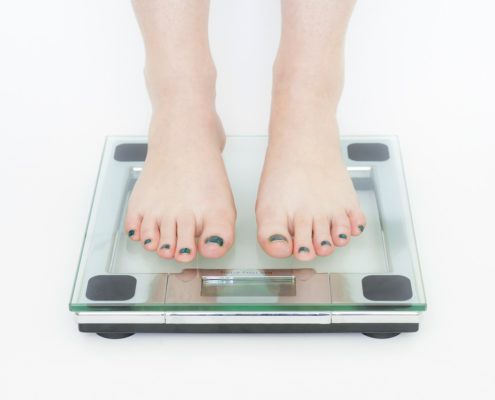Easy Ways to Lose Weight by Lowering Your Setpoint
 If you want to know how to lose weight, you’ve come to the right place. Lowering your setpoint is not only the easiest way to shed pounds, but it is also the only way to long-term weight loss.
If you want to know how to lose weight, you’ve come to the right place. Lowering your setpoint is not only the easiest way to shed pounds, but it is also the only way to long-term weight loss.
This is information hundreds of millions of people need to know today. It is something untold millions of frustrated dieters have been seeking for decades. Instead of correct information about how weight loss really works, everyone received faulty calorie-deficit myth that set them up for failure.
Instead of helping them lose weight, the starvation diets they tried raised their setpoint, causing them to gain more weight. Ironically, the obesity epidemic may be one of the unforeseen consequences of the calorie-cutting, calorie-deficit mindset.
Dieting: When it Doesn’t Help You Lose Weight
Yo-yo dieting is a common problem for most dieters. They lose weight, and then they gain it back plus a few more pounds. They lose weight again, and then they gain it back plus a few more pounds. And the cycle continues. Indeed, this cycle is almost impossible to end because nobody told them the truth about the setpoint and how it determines weight. Nobody told them they need to lower the setpoint to lose weight permanently.
Instead, millions of people continue yo-yo dieting, gaining more weight back than they lost. Just a few cycles of yo-yo dieting can lead to obesity. This is how dieting itself contributes to the obesity epidemic.
According to the World Health Organization (WHO), the numbers of obese individuals worldwide have almost tripled since 1975. Further, the WHO reports that in 2016, 1.9 billion adults were overweight, and 650 million were obese. Obesity is a condition in which the levels of body fat are sufficient as to negatively impact health. Though obesity significantly increases the risk of many health conditions, any extra weight can be dangerous to your mental, physical, and emotional health.
What are those risks?
Studies show overweight and obesity increases the risk of:
- Type 2 Diabetes
- Depression
- High Blood Pressure
- Heart Disease
- Insulin Resistance
- Abnormal Cholesterol/Triglyceride Levels
- Sleep Apnea
- Some Cancers
- Gallbladder Disease
- Osteoarthritis
Most people know about the health risks of being overweight or obese, and certainly, many of them do not want to carry those extra pounds around. Yet, the obesity epidemic shows no signs of slowing, despite the fact people are trying to lose weight.
Studies show around 45 million American go on diets every year. They spend billions of dollars a year on weight loss products. But research also shows diets fail more than 95% of the time. What gives?
Have You Failed to Lose Weight?
Are you one of the millions of American who go on diets each year, only to fail to achieve your weight loss goals? Are you the Queen (or King) of yo-yo dieting? Do you feel guilt and shame each time gain all the weight back?
Well…LISTEN UP…
You are NOT to blame. Say this out loud: “I am not to blame. It is NOT my fault!”
Though you might feel you’re lying to yourself, you are actually speaking the truth. You did not fail all those diets you tried. They failed YOU. Those diet plans gave you incorrect information that you followed because you thought they had the answers. How could you expect to succeed with incorrect information? And how can anyone blame you for failing in such a circumstance?
The truth is, traditional diets are doomed to failure.
Why Starvation Dieting is not a Good Way to Lose Weight
Almost all traditional diets are built on the premise that you must starve your body to lose weight. This calorie-deficit theory of weight loss treats all calories the same and treats the body as a scale.
The old, “calorie in = calories out” scenario ignores two key features of the metabolism:
- Calories have different effects on the body depending upon which foods they come from.
- The body is not like a scale; it is like a thermostat.
Let’s discuss each of them.
Inside the Body: Why a Calorie is Not the Same as Any Other Calorie
For decades, nutritionists and dieting “experts” have believed all calories are the same. You can eat everything in moderation, this theory goes, as long as you stay within a certain calorie limit. It is so easy to be able to count those calories and know as long as you create a calorie deficit by eating less and/or exercising more, you’ll lose the number of pounds guaranteed by some calorie-deficit calculation.
Only, it doesn’t work like that. One of the reasons is that the body does not treat every calorie the same. The body metabolizes calories differently depending upon the foods from which they came.
For instance, here’s how the metabolism treats calories from refined carbs and sugars. The body digests these foods quickly, enabling rapid absorption into the bloodstream. This causes blood sugar spikes triggering a release of insulin. Insulin is the fat storage hormone, and if there is too much glucose in the bloodstream at one time, insulin just transports most of it to the fat cells. That’s because insulin must clear glucose quickly to prevent levels from rising dangerously high.
By contrast, high-protein foods take 10% to 20% more energy to digest as refined carbs and sugars. This means that if a piece of chicken is 300 calories, you burn up to 60 calories just digesting it. After it is broken down into amino acids, the amino acids are sent to the bloodstream to repair and build cells. This burns more calories, as do several other metabolic processes protein undergoes. The result is that it is difficult for the body to store protein as body fat.
It makes no sense to treat every calorie the same if they have different effects and different rates of calorie burn inside the body!
Inside the Body: Why the Body is Not Like a Scale
The body is also not like a scale. It is more like a thermostat. You see, your body is a beautifully complex machine well capable of regulating your weight in the same way it regulates your heart rate, blood pressure, body temperature, and more.
Your brain, digestive system, and hormones talk to each other through a continuous feedback loop to synchronize the activities that automatically maintain body fat (setpoint weight) at a specified level. You can think of this system as the thermostat in your house. Based on the thermostat, your heating and air conditioning system keeps your home at whatever temperature the thermostat “thinks” it should be at.
Similarly, your setpoint stimulates or suppresses your appetite and raises or lowers metabolism in response to how much fat it “thinks” you should store.
Setpoint: The Missing Factor in Traditional Diet
The setpoint is a factor that determines your weight, and it doesn’t matter how little you eat or how much you exercise. About 50% of your setpoint is determined by genetics. The other 50% is determined by diet and other lifestyle factors. Everything you do either positively or negatively affects setpoint, but there are three main causes of an elevated setpoint: poor-quality diet, stress, and sleep deprivation.
- Poor-quality diet: Regularly consuming refined carbs, sugars, processed fats, heavily processed foods, and fast foods create a hormonal clog that prevents hormones from sending proper signals. The body doesn’t know how much fat you need, so it gives you more fat just in case. The result is an elevated setpoint.
- Stress: Stress triggers a release of the stress hormone cortisol, which then triggers a release of the hormone insulin. Both of these hormones lead to an accumulation of excess fat.
- Sleep deprivation: Sleep is not only important to your mental state. It is also important to your setpoint. Many studies show a lack of adequate sleep dysregulates several hormones, such as cortisol and ghrelin. Sleep deprivation triggers a release of cortisol leading to an accumulation of dangerous belly fat, and ghrelin makes you hungry. Excess cortisol also causes sugar and carb cravings. So, being sleep deprived increases your risk of eating more inSANE foods that cause more belly fat.
Setpoint and Starvation Dieting
 When you cut calories while still eating the same low-quality foods, the body sees this as starvation. It goes on emergency alert, summoning hormones to make you tired, hungry, “hangry.” It also transports most of the calories you DO consume into your fat stores and stops the body from burning any of it. Instead, the body starts burning muscle for energy. The body also slows metabolism to conserve energy and try to keep you close to your setpoint.
When you cut calories while still eating the same low-quality foods, the body sees this as starvation. It goes on emergency alert, summoning hormones to make you tired, hungry, “hangry.” It also transports most of the calories you DO consume into your fat stores and stops the body from burning any of it. Instead, the body starts burning muscle for energy. The body also slows metabolism to conserve energy and try to keep you close to your setpoint.
The result?
As you probably know from your own experience, the weight loss slows down to almost nothing within a few weeks. Think back to your own dieting experiences. Remember when you stepped on the scale after a week of starving yourself, only to discover you hadn’t lost a pound? Or, worse, that you gained a pound or two? How frustrating and depressing. Didn’t it feel like your body was fighting weight loss? That’s because it WAS.
Your body was trying to keep you within 20 pounds of your setpoint to keep you from dying. If you try to lose weight by starvation dieting, you are fighting your body’s self-preservation instinct, and the body will win.
You will lose weight on a starvation diet, but the setpoint ensures you’ll gain it all back plus several more pounds. The only way to lose weight long term is to lower your setpoint weight.
The three best ways to lower setpoint weight is by eating high-quality SANE foods, lowering stress, and getting more sleep.
Lowering Setpoint with the SANE Eating Plan
With the SANE eating plan, there are no complicated diet principles to remember. All you really need to remember is to eat foods from four food groups, with the goal of being so full of these SANE foods, you’ll be too full for inSANE ones.
Here are the four food groups with recommended serving amounts.
- Non-Starchy Vegetables: At least 10 servings per day
- Nutrient-Dense Proteins: 3-5 servings per day, 30-50 grams per meal
- Whole-Food Fats: 3-6 servings per day
- Low-Fructose Fats: 0-3 servings per day
These foods have been scientifically proven to remove hormonal clogs, trigger fat-burning hormones, eliminate sugar/carb cravings, keep you full for a long time, and lower your setpoint.
Lowering Setpoint by De-Stressing
It is so difficult sometimes to find time to de-stress, but lowering your setpoint to lose weight and feel great depends upon it.
Anything you enjoy doing relieves stress. Here are some ideas to get you started:
- Meditation
- Yoga
- TaiChi
- Deep Breathing
- Progressive relaxation
- Leisure Walking
- Listening to calming music
- Playing with your dog or cat
- Leisurely bicycle riding
- Binge-watching sitcoms
- Going bowling with friends
- Making love
Lowering Setpoint by Getting More Sleep
Getting enough sleep every night is something many people struggle with. It’s not easy getting a good night’s sleep after having a stressful day and handling all your commitments. But if you want to lower your setpoint, it is important that you get at least 7-8 hours of quality sleep every night.
Here are a few tips to help you get more and better sleep.
Put away all devices. The light from your smartphone, tablet, and other devices interferes with your brain’s production of the sleep hormone melatonin. For a good night’s sleep, put all your devices away at least one hour prior to bedtime.
Avoid food and drink. Eating or drinking before bedtime can disrupt your sleep. The digestive process of food can cause nightmares and other sleep disturbances, while drink can cause you to wake up several times during the night to go to the bathroom. To avoid this problem, try not to eat or drink anything 3-4 hours before bedtime.
Adhere to a set sleep schedule. Going to bed at the same time every night trains your body to be tired at that time. It is also important that you rise at the same time every morning — even on the weekends — so that your body stays on a sleep schedule.
Don’t take naps during the day. Taking a nap may make it difficult for you to fall asleep at night.
Next Step: Learn the Easy Ways to Lose Weight by Lowering Your Setpoint with the SANE
Ready to finally break free from the yo-yo dieting rollercoaster by balancing your hormones and lowering your body’s setpoint weight?
Want to know the exact foods and serving sizes that are scientifically proven by over 1,300 peer-reviewed research studies to boost metabolism, burn fat and enjoy virtually effortless weight loss like a naturally thin person?
Download the free SANE metabolism boosting food list, cheat sheet and “Eat More, Burn More” weight loss program by .







Leave a Reply
Want to join the discussion?Feel free to contribute!